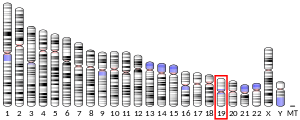OR7D4
Olfactory receptor 7D4 is a protein that in humans is encoded by the OR7D4 gene.[4][5][6][7][8][9][10]
| OR7D4 | |||||||||||||||||||||||||
|---|---|---|---|---|---|---|---|---|---|---|---|---|---|---|---|---|---|---|---|---|---|---|---|---|---|
| Identifiers | |||||||||||||||||||||||||
| Aliases | OR7D4, OR19-7, OR19-B, OR19B, OR7D4P, hg105, olfactory receptor family 7 subfamily D member 4 | ||||||||||||||||||||||||
| External IDs | OMIM: 611538 MGI: 1313142 HomoloGene: 81583 GeneCards: OR7D4 | ||||||||||||||||||||||||
| |||||||||||||||||||||||||
| |||||||||||||||||||||||||
| Orthologs | |||||||||||||||||||||||||
| Species | Human | Mouse | |||||||||||||||||||||||
| Entrez | |||||||||||||||||||||||||
| Ensembl |
| ||||||||||||||||||||||||
| UniProt |
| ||||||||||||||||||||||||
| RefSeq (mRNA) | |||||||||||||||||||||||||
| RefSeq (protein) |
| ||||||||||||||||||||||||
| Location (UCSC) | Chr 19: 9.21 – 9.22 Mb | n/a | |||||||||||||||||||||||
| PubMed search | [2] | [3] | |||||||||||||||||||||||
| Wikidata | |||||||||||||||||||||||||
| |||||||||||||||||||||||||
Function
Olfactory receptors interact with odorant molecules in the nose, to initiate a neuronal response that triggers the perception of a smell. The olfactory receptor proteins are members of a large family of G protein-coupled receptors (GPCR) arising from single coding-exon genes. Olfactory receptors share a 7-transmembrane domain structure with many neurotransmitter and hormone receptors and are responsible for the recognition and G protein-mediated transduction of odorant signals. The olfactory receptor gene family is the largest in the genome. The nomenclature assigned to the olfactory receptor genes and proteins for this organism is independent of other organisms.[4]
Ligands
People with the OR7D4 R88W/T133M polymorphism are less sensitive to these odorants and find them less offensive smelling, as they are characteristically described as "sweaty".[7]
References
- GRCh38: Ensembl release 89: ENSG00000174667 - Ensembl, May 2017
- "Human PubMed Reference:". National Center for Biotechnology Information, U.S. National Library of Medicine.
- "Mouse PubMed Reference:". National Center for Biotechnology Information, U.S. National Library of Medicine.
- "Entrez Gene: OR7D4 olfactory receptor, family 7, subfamily D, member 4". Retrieved 2013-12-17.
- Fuchs T, Malecova B, Linhart C, Sharan R, Khen M, Herwig R, Shmulevich D, Elkon R, Steinfath M, O'Brien JK, Radelof U, Lehrach H, Lancet D, Shamir R (September 2002). "DEFOG: a practical scheme for deciphering families of genes". Genomics. 80 (3): 295–302. CiteSeerX 10.1.1.135.3652. doi:10.1006/geno.2002.6830. PMID 12213199.
- Malnic B, Godfrey PA, Buck LB (February 2004). "The human olfactory receptor gene family". Proceedings of the National Academy of Sciences of the United States of America. 101 (8): 2584–9. doi:10.1073/pnas.0307882100. PMC 356993. PMID 14983052.
- Keller A, Zhuang H, Chi Q, Vosshall LB, Matsunami H (September 2007). "Genetic variation in a human odorant receptor alters odour perception". Nature. 449 (7161): 468–72. doi:10.1038/nature06162. PMID 17873857.
- OR7D4+protein,+human at the US National Library of Medicine Medical Subject Headings (MeSH)
- Lunde K, Egelandsdal B, Skuterud E, Mainland JD, Lea T, Hersleth M, Matsunami H (2012). Behrens M (ed.). "Genetic variation of an odorant receptor OR7D4 and sensory perception of cooked meat containing androstenone". PLOS ONE. 7 (5): e35259. doi:10.1371/journal.pone.0035259. PMC 3342276. PMID 22567099.
- Wysocki CJ, Beauchamp GK (August 1984). "Ability to smell androstenone is genetically determined". Proceedings of the National Academy of Sciences of the United States of America. 81 (15): 4899–902. doi:10.1073/pnas.81.15.4899. PMC 391599. PMID 6589634.
- Hornung J, Noack H, Thomas M, Farger G, Nieratschker V, Freiherr J, Derntl B (February 2018). "Bayesian informed evidence against modulation of androstadienone-effects by genotypic receptor variants and participant sex: A study assessing Stroop interference control, mood and olfaction". Hormones and Behavior. 98: 45–54. doi:10.1016/j.yhbeh.2017.12.003. PMID 29246659.
- de March CA, Topin J, Bruguera E, Novikov G, Ikegami K, Matsunami H, Golebiowski J (April 2018). "Odorant Receptor 7D4 Activation Dynamics". Angewandte Chemie. 57 (17): 4554–4558. doi:10.1002/anie.201713065. PMC 6268213. PMID 29462498.
This article incorporates text from the United States National Library of Medicine, which is in the public domain.

